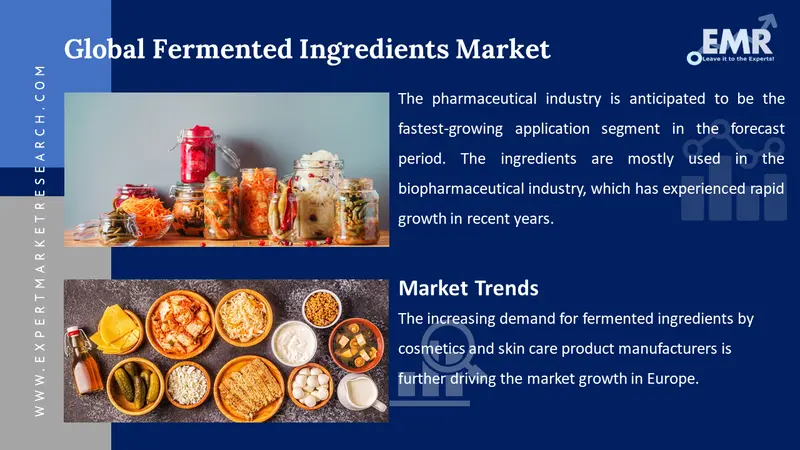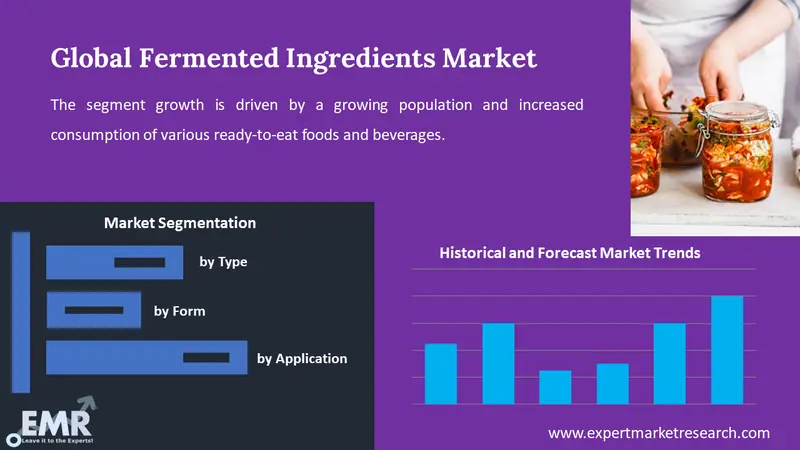
Consumer Insights
Uncover trends and behaviors shaping consumer choices today
Procurement Insights
Optimize your sourcing strategy with key market data
Industry Stats
Stay ahead with the latest trends and market analysis.
The global fermented ingredients market attained a value of nearly USD 19.66 Billion in 2025. The market is further expected to grow at a CAGR of 9.10% during the forecast period of 2026-2035 to reach a value of USD 46.97 Billion by 2035.
Base Year
Historical Period
Forecast Period
Compound Annual Growth Rate
9.1%
Value in USD Billion
2026-2035
*this image is indicative*
| Global Fermented Ingredients Market Report Summary | Description | Value |
| Base Year | USD Billion | 2025 |
| Historical Period | USD Billion | 2019-2025 |
| Forecast Period | USD Billion | 2026-2035 |
| Market Size 2025 | USD Billion | 19.66 |
| Market Size 2035 | USD Billion | 46.97 |
| CAGR 2019-2025 | Percentage | XX% |
| CAGR 2026-2035 | Percentage | 9.10% |
| CAGR 2026-2035 - Market by Region | Asia Pacific | 9.8% |
| CAGR 2026-2035 - Market by Country | India | 10.2% |
| CAGR 2026-2035 - Market by Country | Brazil | 10.0% |
| CAGR 2026-2035 - Market by Form | Liquid | 10.3% |
| CAGR 2026-2035 - Market by Application | Food and Beverages | 10.6% |
| Market Share by Country 2025 | Italy | 2.4% |
Europe is expected to witness significant growth in the forecast period. France is a significant contributor to market growth and is also the fastest-growing market in Europe. High consumption of alcohol, cheese, and yoghurt is a key factor in augmenting the market growth in Europe. The increasing demand for fermented ingredients by cosmetics and skin care product manufacturers is further driving the market growth in Europe. Also, increasing awareness about the health benefits of fermented items among youth is expected to fuel the market growth in the region.

Read more about this report - REQUEST FREE SAMPLE COPY IN PDF
The Asia Pacific region is anticipated to be the fastest-growing fermented ingredients market. The key reasons for the growth of the market are the growing population in countries like India and China, westernisation, increasing per capita income, rising middle-class population, and increased demand for healthy and nutritious food and beverage products with natural ingredients. The improving agricultural growth over the past decade and the advancements in the food and beverage industry in this region have resulted in new opportunities for the fermented ingredients industry. Another factor contributing to the growth of this market is the untapped regions that are not completely tapped by fermented ingredient manufacturers.
The fermented ingredients market finds its major application in food and beverage and pharmaceuticals. The food and beverage market is expected to dominate the market in terms of usage of the product. The segment growth is driven by a growing population and increased consumption of various ready-to-eat foods and beverages. The increasing consumption of beer is also increasing the market share of the food and beverage industry in the global market.
The pharmaceutical industry is anticipated to be the fastest-growing application segment in the forecast period. The ingredients are mostly used in the biopharmaceutical industry, which has experienced rapid growth in recent years. The segment is expected to be driven by the rising biopharmaceutical industry during the forecast period. Due to its high efficiency, the biopharmaceutical sector is booming. It is regarded as modern science's most profound and elegant achievement innovation, thereby boosting the segment growth.

Read more about this report - REQUEST FREE SAMPLE COPY IN PDF
The EMR’s report titled “Fermented Ingredients Market Report and Forecast 2026-2035" offers a detailed analysis of the market based on the following segments:
Market Breakup by Type
Market Breakup by Form
Market Breakup by Application
Market Breakup by Region
| CAGR 2026-2035 - Market by | Country |
| India | 10.2% |
| Brazil | 10.0% |
| China | 9.8% |
| Saudi Arabia | 9.7% |
| UK | 8.7% |
| USA | 8.6% |
| Canada | XX% |
| France | XX% |
| Italy | XX% |
| Japan | XX% |
| Australia | XX% |
| Mexico | XX% |
| Germany | 8.3% |
Amino acid-based fermented ingredients are increasingly being used by food manufacturers to preserve foods and produce high-quality fermented and alcoholic beverages. Thus, the growing awareness regarding food preservation is driving the market growth of fermented ingredients globally. The increased health consciousness among the public about the benefits of consuming fermented foods is propelling the market growth forward. Fermented ingredients are made up of beneficial bacteria and yeast that break down carbs, starches, and sugars in food and can be used to make kimchi, tempeh, kombucha, and yoghurt. In line with this, the increased demand for fermented ingredients in the pharmaceutical industry is also contributing to market expansion. These substances are commonly used to break down molecules in aerobic or anaerobic environments and increase the bioavailability of therapeutic compounds. Also, the high demand for antibiotics and lifestyle-based ailments such as obesity and digestive issues are expected to drive the global fermented ingredients industry over the predicted years. Other factors, including the increasing utilisation of fermented ingredients in animal feed and extensive research and development activities, are anticipated to drive market growth in the world.
The report gives a detailed analysis of the following key players in the global fermented ingredients market, covering their competitive landscape, capacity, and latest developments like mergers, acquisitions, and investments, expansions of capacity, and plant turnarounds:
The comprehensive EMR report provides an in-depth assessment of the market based on the Porter's five forces model along with giving a SWOT analysis.




*While we strive to always give you current and accurate information, the numbers depicted on the website are indicative and may differ from the actual numbers in the main report. At Expert Market Research, we aim to bring you the latest insights and trends in the market. Using our analyses and forecasts, stakeholders can understand the market dynamics, navigate challenges, and capitalize on opportunities to make data-driven strategic decisions.*
Get in touch with us for a customized solution tailored to your unique requirements and save upto 35%!
The global fermented ingredients market is projected to grow at a CAGR of 9.10% between 2026 and 2035.
The market is estimated to witness a healthy growth in the forecast period of 2026-2035 to reach USD 46.97 Billion by 2035.
The major drivers of the market include the increasing demand for fermented ingredients by cosmetics and skin care product manufacturers, westernisation, increasing per capita income, rising middle-class population, increased demand for fermented ingredients in the pharmaceutical industry, increasing utilisation of fermented ingredients in animal feed and extensive research and development activities.
The growing awareness regarding food preservation and increased health consciousness among the public about the benefits of consuming fermented foods are the key industry trends propelling the growth of the market.
The major regions in the industry are North America, Latin America, the Middle East and Africa, Europe, and the Asia Pacific.
The different types of fermented ingredients are amino acids, organic acids, polymers, vitamins, industrial enzymes, and antibiotic.
Based on form, the market is divided into dry and liquid.
The significant applications of the market are food and beverages, feed, pharmaceutical, and industrial, among others.
The major players in the industry are Archer Daniels Midland Company, Cargill, Incorporated, International Flavors & Fragrances Inc. (Dupont), Ohly, Lonza Group Ltd, and Döhler GmbH, among others.
In 2025, the market reached an approximate value of USD 19.66 Billion.
Explore our key highlights of the report and gain a concise overview of key findings, trends, and actionable insights that will empower your strategic decisions.
| REPORT FEATURES | DETAILS |
| Base Year | 2025 |
| Historical Period | 2019-2025 |
| Forecast Period | 2026-2035 |
| Scope of the Report |
Historical and Forecast Trends, Industry Drivers and Constraints, Historical and Forecast Market Analysis by Segment:
|
| Breakup by Type |
|
| Breakup by Form |
|
| Breakup by Application |
|
| Breakup by Region |
|
| Market Dynamics |
|
| Competitive Landscape |
|
| Companies Covered |
|
| Report Price and Purchase Option | Explore our purchase options that are best suited to your resources and industry needs. |
| Delivery Format | Delivered as an attached PDF and Excel through email, with an option of receiving an editable PPT, according to the purchase option. |
Datasheet
One User
USD 2,499
USD 2,249
tax inclusive*
Single User License
One User
USD 3,999
USD 3,599
tax inclusive*
Five User License
Five User
USD 4,999
USD 4,249
tax inclusive*
Corporate License
Unlimited Users
USD 5,999
USD 5,099
tax inclusive*
*Please note that the prices mentioned below are starting prices for each bundle type. Kindly contact our team for further details.*
Flash Bundle
Small Business Bundle
Growth Bundle
Enterprise Bundle
*Please note that the prices mentioned below are starting prices for each bundle type. Kindly contact our team for further details.*
Flash Bundle
Number of Reports: 3
20%
tax inclusive*
Small Business Bundle
Number of Reports: 5
25%
tax inclusive*
Growth Bundle
Number of Reports: 8
30%
tax inclusive*
Enterprise Bundle
Number of Reports: 10
35%
tax inclusive*
How To Order

Select License Type
Choose the right license for your needs and access rights.

Click on ‘Buy Now’
Add the report to your cart with one click and proceed to register.

Select Mode of Payment
Choose a payment option for a secure checkout. You will be redirected accordingly.
Gain insights to stay ahead and seize opportunities.

Get insights & trends for a competitive edge.

Track prices with detailed trend reports.

Analyse trade data for supply chain insights.

Leverage cost reports for smart savings

Enhance supply chain with partnerships.

Connect For More Information
Our expert team of analysts will offer full support and resolve any queries regarding the report, before and after the purchase.
Our expert team of analysts will offer full support and resolve any queries regarding the report, before and after the purchase.
We employ meticulous research methods, blending advanced analytics and expert insights to deliver accurate, actionable industry intelligence, staying ahead of competitors.
Our skilled analysts offer unparalleled competitive advantage with detailed insights on current and emerging markets, ensuring your strategic edge.
We offer an in-depth yet simplified presentation of industry insights and analysis to meet your specific requirements effectively.
Share